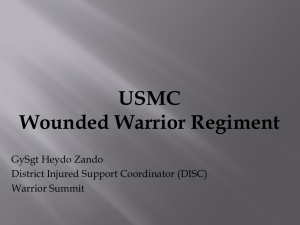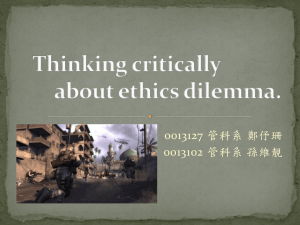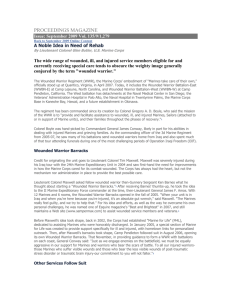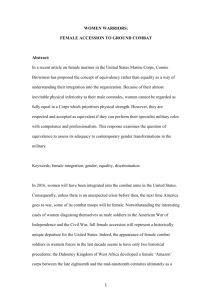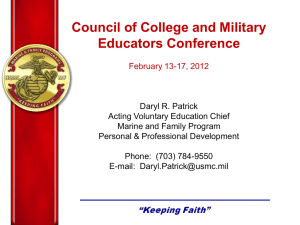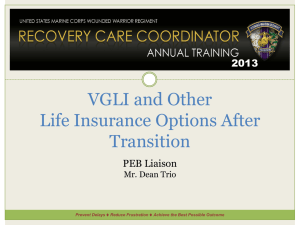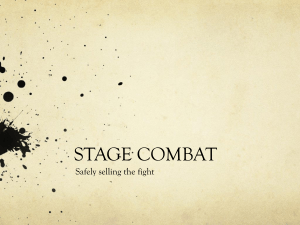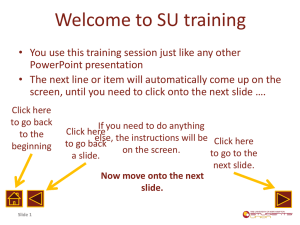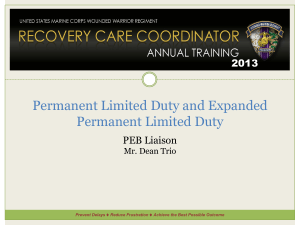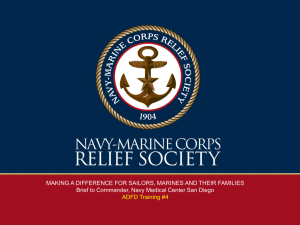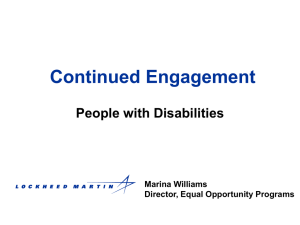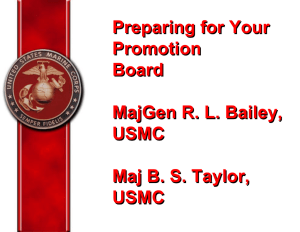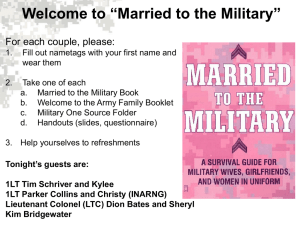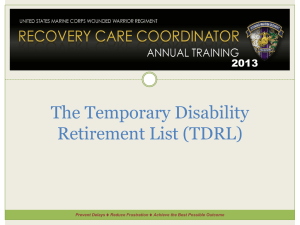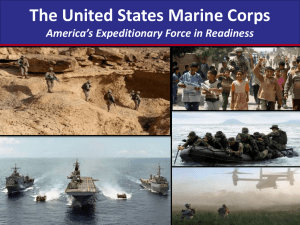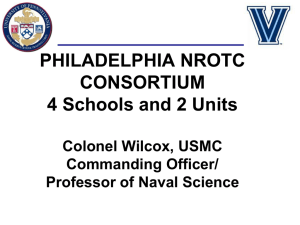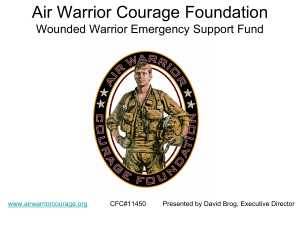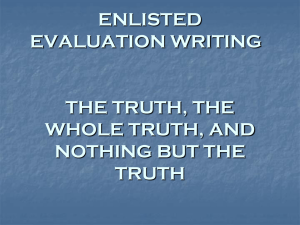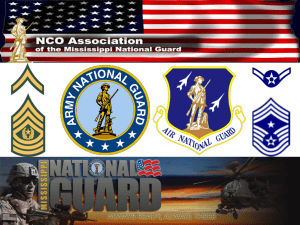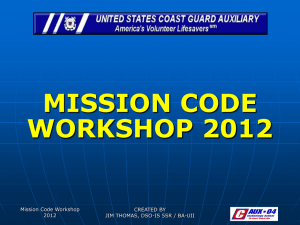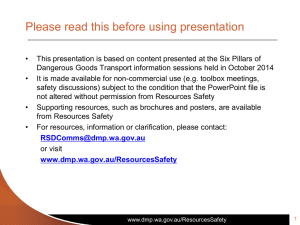Understanding Military Culture - Mental Health America of Wisconsin
advertisement
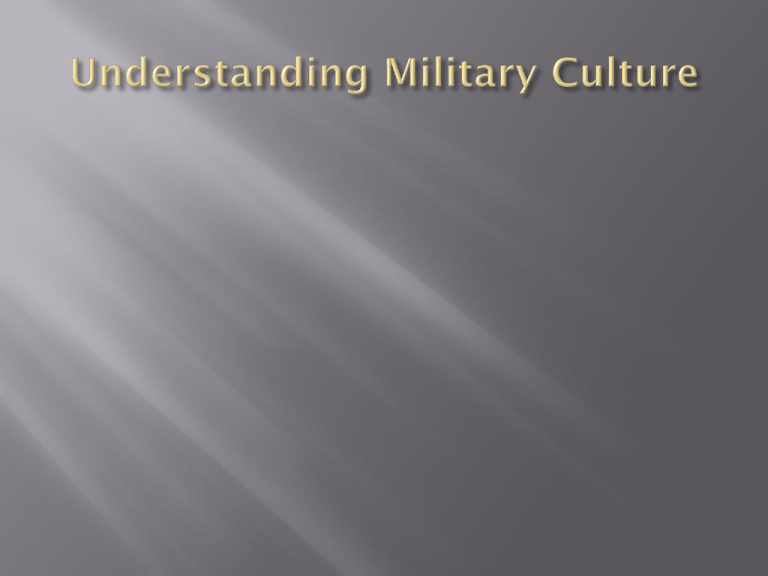
Branches of the Military Army- Founded in 1775 Navy- Founded in 1775 Referred to as Marines Coast Guard- Founded in 1790 Referred to as Sailors Marines- Founded in 1775 Referred to as Soldiers or Warriors Referred to as Guardians Air Force- Founded in 1947 Referred to as Airmen Branch Components Active Duty Full-time, paid through federal government All branches have an active component During deployments Service Members may be required to work long hours to complete missions Reserve Part-time, paid through federal government Typically train one weekend a month and two weeks a fiscal year during Annual Training (AT) May be called suddenly to active duty orders/assignments or deployments Leave family, jobs, school and community National Guard Part-time, paid through state and federal government Army and Air Force only Deployment length: Army Navy Marine deployments are typically 6-9 months Marine Reservists could miss 1-2 semesters Air Force Typically serve on ships, some are assigned to other branches Sea to shore ratio depends on job and rank Marine Corps Typical deployment is 12 months. Reserve/Guard soldiers may miss 2-3 semesters. Standard deployment length is 4 months Reserve/Guard may miss 1-2 semesters Coast Guard Most units do not deploy because of domestic mission Three month deployments for select units and special missions Rank and Structure There are three types of rank: Enlisted- includes noncommissioned officers and petty officers (pay grades E-1 through E-9) (84% the military is enlisted) Warrant Officers- highly specialized subject matter experts (pay grades W-1 through W-5) Commissioned Officers- highest ranking officials, either attended a military service academy or ROTC at a four-year college (or attended an officer cadet training course as prior enlisted) (pay grades O-1 through O-10) (14% of the military) For a visual guide to enlisted rank structure, go to: http://www.defense.gov/about/insignias/enlisted.aspx For officer rank, go to: http://www.defense.gov/about/insignias/officers.aspx Job Specialty: MOS: Military (or Marine) Occupational Specialty NEC: Navy Enlisted Classification Rate: Coast Guard term for job title AFSC: Air Force Specialty Code MOS/NEC/Rate/AFSC indicates the type of job, duties or specialty performed in the military. For example: In the Army, Infantry Soldiers (Basic Rifleman) have an MOS designation of 11B (or 11C if they have additional training as mortar man), but in the Marine Corps an infantryman has an 03 (0311=rifleman) indicator. Every enlisted Service Member goes through Basic Combat Training or “Boot Camp”! In Basic Combat Training… You are broken down to be built back up. You are stripped of your individuality. Degredation ceremony-used to initiate people into a total institution such as mental hospitals, prisons, and military units. The purpose is to deprive people of their former identities and dignity in order to make them more accepting of external control. (about.com) Team work, camaraderie and espirit de corps are all emphasized. You are assigned a “Battle Buddy” Introduced to a structured chain-of-command You are trained for combat and to be ready when called upon YOU LEARN A NEW LANGUAGE… Military acronyms: AWOL-Absent With Out Leave BAH-Basic Allowance for Housing DFAC-Dining Facility DZ-Drop Zone FOB-Forward Operating Base G.I.-General Issue IED-Improvised Explosive Device JAG-Judge Advocate General KIA-Killed in Action MEDEVAC-MEDical EVACuation MIA-Missing in Action RECON-Reconnaissance SOP-Standard Operating Procedures OIF-Operation Iraqi Freedom OEF-Operation Enduring Freedom Operation New Dawn GWOT-Global War on Terrorism VA-Veterans Administration NCO- Non-Commissioned Officer ROTC-Reserve Officer Training Corps DoD-Department of Defense MRE-Meal, Ready to Eat OPSEC-Operation Security EAP-Emergency Action Plan ROE-Rules of Engagement RUF-Rules of the Use of Force OPORD-Operations Order FRAGO-Fragmentary Order Dependent-Spouse, child, or other person who is dependent of the service member for support AT-Annual Training MUTA-Military Unit Training Assembly The military… Emphasizes group cohesion & espirit de corps that connect service members to each other. Has a distinct set of ceremony and etiquette that create shared rituals and common identities. Maintains a high standard of discipline that helps organize and structure the armed forces Emphasizes the importance of always doing your best and giving 100% (anything less isn’t acceptable and, in combat, can lead to people getting hurt or killed.) Emphasizes attention to detail. Emphasizes punctuality If you show up early, you’re on time. If you show up on time, you’re late. Establishes a professional, or warrior, ethos of loyalty and selfless-service that maintains order during battle. Mission First! Loyalty Duty Respect Integrity first Selfless-Service Honor Honor Courage Integrity Commitment Personal Courage Service before Self Excellence in all we do Honor Honor Courage Respect Commitment Devotion to Duty Core Values Understanding our current conflicts (2001-Present)… Global War on Terrorism Operation Active Endeavor (Mediterranean Sea) 2001-Present Operation Enduring Freedom (2002-Present) Afghanistan Philippines Horn of Africa Trans Sahara Operation Iraqi Freedom (2003-2010) Operation New Dawn (Iraq after August 2010) Service members can be deployed multiple times in support of these conflicts. Common military stressors/experiences Acculturation into the Armed Forces (Basic Combat Training/Boot Camp) Exposure to combat or life threatening situations Loss of a close friend, team member or leader Inner conflict/self-doubt Wear and tear Operational Stress-Lack of sleep/rest High expectations at all times Physically and mentally worn down Common myths about the military: People who join have low intelligence or are without opportunities Women have a hard time achieving success Military jobs and training have little relation with the civilian world The military is only for people who like war/fighting War=Combat Once you go to war, you come home and are done with your military service The military will let anyone in who applies Transitioning service members can often… Feel “lost” or “alone” (no one understands them or can relate to their experiences) Struggle with not having structure or goals Worry about finances or taking care of their family Miss the adrenaline rush associated with various military experiences Become easily annoyed with civilians who take things less seriously or are too “laid back” May have anger or resentment towards those who did not serve or towards other military personnel Feel and edge or tense Feel that everything back home has changed Feel down or depressed soon after being separated from service or coming home from deployment Myths about Veterans: They’re “crazy” or “ticking time-bombs” Ready to snap at any moment They’re “baby killers” and “war mongers” They all have PTSD or TBI issues About 11-20% of OIF/OEF Veterans, and 10% of Gulf War Veterans experience PTSD. They challenges they face… Service Connected Injuries/Disabilities Transition from military to civilian life PTSD and TBI Sleep issues Hearing loss/tinnitus Back/Leg problems Concerns about personal safety (hyper- vigilance) Lack of strong support network/structure (interdependence) Financial issues Retirement issues Leadership Characteristics: Lead by example Carefully consider directions Inspire and influence Providing purpose, direction and motivation Collaborative Team Member: Complete their duties by accomplishing tasks as part of a team. Flexibility and Adaptability: Learned to be flexible and adaptable to meet the constantly changing situation, mission and environment. Self-Directed: Trained to understand and solve difficult problems and complex tasks. Their ability to function efficiently independent makes them dependable and reliable. Outstanding Work habits: Possess pride and enthusiasm for their work. Personal integrity by adhering to moral principles. Invested in their Community: Strong desire to be productive citizens and serve their community with selfless sacrifice. Share if you have a personal connection to the military Validate their military background and show “respect” to build rapport and trust Being punctual Directly connecting to needed services Giving clear steps for “mission” that needs to be accomplished Follow-up after appointments (stay on their radar) Need to be direct and concise with requests Being mindful of political sensitivities/patriotism Be clear and up front Don’t ask the wrong questions Know current Veteran Resources available in the community, at the VA and other resources to support Veterans and their families USMC Wounded Warrior Regiment GySgt Heydo Zando District Injured Support Coordinator (DISC) Warrior Summit Provides and enables assistance to wounded, ill, and injured (WII) Marines, sailors attached to or in support of Marine units, and their family members in order to assist them as they return to duty or transition to civilian life. • Serves the total force – active duty, reserve, retired, and veteran Marines. • The only official Marine Corps unit charged with providing nonmedical care to WII Marines. IED Blast Cancer Training Accident Gunshot Chronic Illness Vehicle Accident Traumatic Brain Injury Mental Health Post Traumatic Stress Wounded Warrior Regiment support is not a factor of luck and location 22 Providing individualized support through the phases of recovery. Photo by Dan Gross, The Gazette Marines Stay in the FIGHT! 2323 Complex Care (Active Duty / Reserve) As of August 2014 Marines Joined to the WWR East: 315 West: 177 492 Joined Marines : • Transferred by Service Record (TR/SR) or Temporary Assigned Duty (TAD) • Assigned an RCC Total Marines in the IDES Process Veteran 2,730 Sergeant Merlin German Wounded Warrior Call Center + External Marines Supported by an RCC 453 22% TOTA 945 L = External Marines : • Not joined to the WWR (Marines who have stayed with their parent unit) • Assigned an RCC • Receive support from the WWR (example) Incident Type: Joined and External Population Patients supported by the WWR at a MTF (not part of total number) PTSD, Trainin g Acciden t Ill/Injure d In Combat Zone 19% 50 Combat Wounded 26% TBI, Gun Shot, Burns Auto Accident, Cancer Ill/Injure d Outside Combat Zone 55% N=945 Source: (MCTFS) Source: Marine Corps Total Force System (MCTFS) Marines joined to the WWR or supported by an RCC in the IDES Process 589 Marines joined to WWR or supported by an RCC in various MEB Phase IDES phases 154 Transition VA Benefits Source: Veterans Tracking Application (VTA) 3,598 Marines who remain with parent unit Active Duty / Reserve 29,096 Veteran Source: MCWIITS 210 169 PEB Phase District Injured Support Coordinator Support 764 Disability retired and Veteran Marines receiving, as needed, short or long-term recovery support Source: DISC Program Manager 44 (12 Cases Between Phases WWR Staffing Marine : 320 (Active Duty and Reserve) Civilians: 120 (GS and NAF) Contractors: 104 Total: 544 CMC expressed intent that WII Marines should remain assigned to their parent units, so long as their medical conditions allow and their units can support them. WWR provides services to help Commander’s ensure WII Marines’ productive recoveries via: • Wounded Warrior Battalions East and West Contact Center: Outreach to Marines (Active Duty and Reserve) who remain with their parent commands • Recovery Care Coordinators: RCCs support qualified external cases with Comprehensive Recovery Plans • WWR Medical Cell: Medical Advocacy (TBI and PTS) and liaison to the medical community • District Injured Support Coordinators: Support transitioning Marines in their communities • Administrative Support (WWR has sole responsibility for Traumatic Servicemembers’ Group Life Insurance, Special Compensation for Assistance With Activities of Daily Living, Pay and Allowance Continuation) • Integrated Disability Evaluation System Advocacy WWR provides Commanders tools and guidance to help them support their WII Marines: “Does my Marine require an RCC?” “Does my Marine qualify for special compensation?” 25 25 Communication is Key to Support WWR Call Center / Contact Centers • Sergeant Merlin German Wounded Warrior Call Center Monthly call volume: 9,500 outreach / 1,200 incoming Target population: Veteran Marines (TDRL, Purple Heart, PCR) Population total: Nearly 30,000 • Wounded Warrior Battalion Contact Centers Monthly call volume (combined): 3,500 outreach / 400 incoming Target population: Recovering Marines with their parent commands Population total: Nearly 4,000 Social Media • Facebook Includes a Support Form Over 100,000 Followers! • Twitter • YouTube • Flickr WWR Mobile Application • Recent launch of version 2.0 • Provides prompt and easy access to WWR resources • Over 6,000 downloads! WWR Quarterly Report • One-page report suitable for internal and external audiences • Downloadable from the WWR website Sergeant Merlin German Whether at war or in times of peace the WWR will continue to care for our WII Marines. Never before has recovery care been so comprehensive. Care assets are aligned under a single command – the WWR. Support must be enduring in view of issues resulting from the current decade of war: Catastrophic injuries and illnesses requiring acute care Traumatic brain injuries Psychological health problems including PTS Conditions such as TBI and PTS are not solved by short-term care, and will require continuing services. “I think it’s probably one of the greatest success stories coming out of this war.” “The wounds of this war will be with us for a long time.” “We also have typical things that happen to our young men and women – cancer, accidents, tragedies that happen.” “My sense is that it will be around for a long time.” Gen Amos: Speaking about the WWR 27 John P. Teske, Psy.D. 920-498-5595 John.Teske@nwtc.edu Jeremy Galica 920-498-5744 Jeremy.Galica@nwtc.edu GySgt. Zando 414-350-2618 Heydo.Zando@usmc.mil Wendy Burdick 608-372-3971 (x66810) Wendy.r.burdick2.ctr@mail.mil Thank you for your contribution to helping our veteran students
